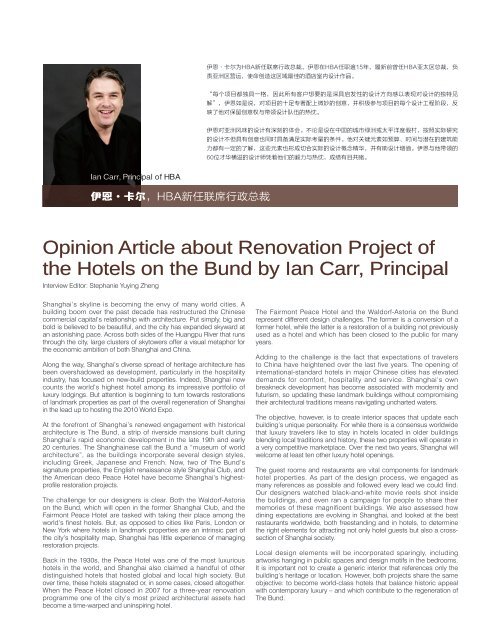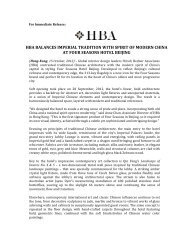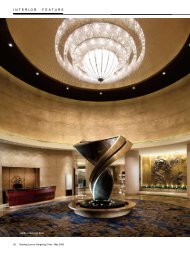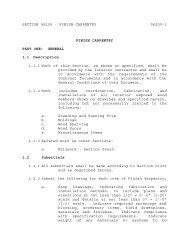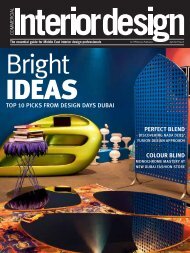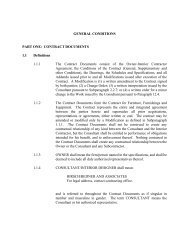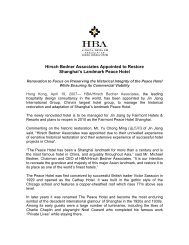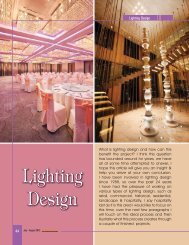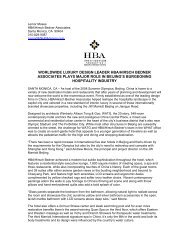LH858-封面封底R1.ps, page 2 @ Preflight ( \\192.168.0.105\mac ...
LH858-封面封底R1.ps, page 2 @ Preflight ( \\192.168.0.105\mac ...
LH858-封面封底R1.ps, page 2 @ Preflight ( \\192.168.0.105\mac ...
- No tags were found...
You also want an ePaper? Increase the reach of your titles
YUMPU automatically turns print PDFs into web optimized ePapers that Google loves.
伊 恩 · 卡 尔 为 HBA 新 任 联 席 行 政 总 裁 。 伊 恩 在 HBA 任 职 逾 15 年 , 履 新 前 曾 任 HBA 亚 太 区 总 裁 , 负责 亚 洲 区 营 运 , 使 命 创 造 这 区 域 最 佳 的 酒 店 室 内 设 计 作 品 。“ 每 个 项 目 都 独 具 一 格 , 因 此 所 有 客 户 想 要 的 是 深 具 启 发 性 的 设 计 方 向 感 以 表 现 对 设 计 的 独 特 见解 ”, 伊 恩 如 是 说 , 对 项 目 的 十 足 专 著 配 上 微 妙 的 创 意 , 并 积 极 参 与 项 目 的 每 个 设 计 工 程 阶 段 , 反映 了 他 对 保 留 创 意 权 与 带 领 设 计 队 伍 的 热 忱 。伊 恩 对 亚 洲 风 味 的 设 计 有 深 刻 的 体 会 。 不 论 是 设 在 中 国 的 城 市 绿 洲 或 太 平 洋 度 假 村 , 按 照 实 际 研 究的 设 计 不 但 具 有 创 意 也 同 时 具 备 满 足 实 际 考 量 的 条 件 。 他 对 关 键 元 素 如 预 算 、 时 间 与 潜 在 的 建 筑 能力 都 有 一 定 的 了 解 , 这 些 元 素 也 形 成 切 合 实 际 的 设 计 概 念 精 华 , 并 有 助 设 计 增 值 。 伊 恩 与 他 带 领 的60 位 才 华 横 溢 的 设 计 师 凭 着 他 们 的 毅 力 与 热 忱 , 成 绩 有 目 共 睹 。Ian Carr, Principal of HBA伊 恩 · 卡 尔 ,HBA 新 任 联 席 行 政 总 裁Opinion Article about Renovation Project ofthe Hotels on the Bund by Ian Carr, PrincipalInterview Editor: Stephanie Yuying ZhengShanghai’s skyline is becoming the envy of many world cities. Abuilding boom over the past decade has restructured the Chinesecommercial capital’s relationship with architecture. Put simply, big andbold is believed to be beautiful, and the city has expanded skyward atan astonishing pace. Across both sides of the Huangpu River that runsthrough the city, large clusters of skytowers offer a visual metaphor forthe economic ambition of both Shanghai and China.Along the way, Shanghai’s diverse spread of heritage architecture hasbeen overshadowed as development, particularly in the hospitalityindustry, has focused on new-build properties. Indeed, Shanghai nowcounts the world’s highest hotel among its impressive portfolio ofluxury lodgings. But attention is beginning to turn towards restorationsof landmark properties as part of the overall regeneration of Shanghaiin the lead up to hosting the 2010 World Expo.At the forefront of Shanghai’s renewed engagement with historicalarchitecture is The Bund, a strip of riverside mansions built duringShanghai’s rapid economic development in the late 19th and early20 centuries. The Shanghainese call the Bund a “museum of worldarchitecture”, as the buildings incorporate several design styles,including Greek, Japanese and French. Now, two of The Bund’ssignature properties, the English renaissance style Shanghai Club, andthe American deco Peace Hotel have become Shanghai’s highestprofilerestoration projects.The challenge for our designers is clear. Both the Waldorf-Astoriaon the Bund, which will open in the former Shanghai Club, and theFairmont Peace Hotel are tasked with taking their place among theworld’s finest hotels. But, as opposed to cities like Paris, London orNew York where hotels in landmark properties are an intrinsic part ofthe city’s hospitality map, Shanghai has little experience of managingrestoration projects.Back in the 1930s, the Peace Hotel was one of the most luxurioushotels in the world, and Shanghai also claimed a handful of otherdistinguished hotels that hosted global and local high society. Butover time, these hotels stagnated or, in some cases, closed altogether.When the Peace Hotel closed in 2007 for a three-year renovationprogramme one of the city’s most prized architectural assets hadbecome a time-warped and uninspiring hotel.The Fairmont Peace Hotel and the Waldorf-Astoria on the Bundrepresent different design challenges. The former is a conversion of aformer hotel, while the latter is a restoration of a building not previouslyused as a hotel and which has been closed to the public for manyyears.Adding to the challenge is the fact that expectations of travelersto China have heightened over the last five years. The opening ofinternational-standard hotels in major Chinese cities has elevateddemands for comfort, hospitality and service. Shanghai’s ownbreakneck development has become associated with modernity andfuturism, so updating these landmark buildings without compromisingtheir architectural traditions means navigating uncharted waters.The objective, however, is to create interior spaces that update eachbuilding’s unique personality. For while there is a consensus worldwidethat luxury travelers like to stay in hotels located in older buildingsblending local traditions and history, these two properties will operate ina very competitive marketplace. Over the next two years, Shanghai willwelcome at least ten other luxury hotel openings.The guest rooms and restaurants are vital components for landmarkhotel properties. As part of the design process, we engaged asmany references as possible and followed every lead we could find.Our designers watched black-and-white movie reels shot insidethe buildings, and even ran a campaign for people to share theirmemories of these magnificent buildings. We also assessed howdining expectations are evolving in Shanghai, and looked at the bestrestaurants worldwide, both freestanding and in hotels, to determinethe right elements for attracting not only hotel guests but also a crosssectionof Shanghai society.Local design elements will be incorporated sparingly, includingartworks hanging in public spaces and design motifs in the bedrooms.It is important not to create a generic interior that references only thebuilding’s heritage or location. However, both projects share the sameobjective: to become world-class hotels that balance historic appealwith contemporary luxury – and which contribute to the regeneration ofThe Bund.


